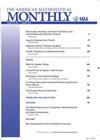The Probabilistic Pigeonhole Principle
IF 0.4
4区 数学
Q4 MATHEMATICS
引用次数: 0
Abstract
The pigeonhole principle states that if n pigeons are put into m < n pigeonholes, then at least two pigeons must be in the same hole. What happens if there are more pigeonholes than pigeons and the pigeons are placed in the pigeonholes randomly? For example, if each among 50 shades of grey are chosen at random from 256 possibilities, can one assert that there are at least two identical choices? Yes, almost surely one can! See Corollary 1. Theorem (Probabilistic Pigeonhole Principle). Given a positive integer m and p ∈ [0, 1), let n be an integer that is larger than or equal to概率鸽子洞原理
鸽子洞原理指出,如果将n只鸽子放入m < n个鸽子洞中,则至少有两只鸽子在同一个鸽子洞中。如果鸽子洞比鸽子多,鸽子被随机放置在鸽子洞里,会发生什么?例如,如果从256种可能性中随机选择50种灰度中的每一种,人们是否可以断言至少有两个相同的选择?是的,几乎可以肯定!参见推论1。定理(概率鸽子洞原理)。给定正整数m, p∈[0,1],设n为大于等于的整数
本文章由计算机程序翻译,如有差异,请以英文原文为准。
求助全文
约1分钟内获得全文
求助全文
来源期刊

American Mathematical Monthly
Mathematics-General Mathematics
CiteScore
0.80
自引率
20.00%
发文量
127
审稿时长
6-12 weeks
期刊介绍:
The Monthly''s readers expect a high standard of exposition; they look for articles that inform, stimulate, challenge, enlighten, and even entertain. Monthly articles are meant to be read, enjoyed, and discussed, rather than just archived. Articles may be expositions of old or new results, historical or biographical essays, speculations or definitive treatments, broad developments, or explorations of a single application. Novelty and generality are far less important than clarity of exposition and broad appeal. Appropriate figures, diagrams, and photographs are encouraged.
Notes are short, sharply focused, and possibly informal. They are often gems that provide a new proof of an old theorem, a novel presentation of a familiar theme, or a lively discussion of a single issue.
Abstracts for articles or notes should entice the prospective reader into exploring the subject of the paper and should make it clear to the reader why this paper is interesting and important. The abstract should highlight the concepts of the paper rather than summarize the mechanics. The abstract is the first impression of the paper, not a technical summary of the paper. Excessive use of notation is discouraged as it can limit the interest of the broad readership of the MAA, and can limit search-ability of the article.
 求助内容:
求助内容: 应助结果提醒方式:
应助结果提醒方式:


